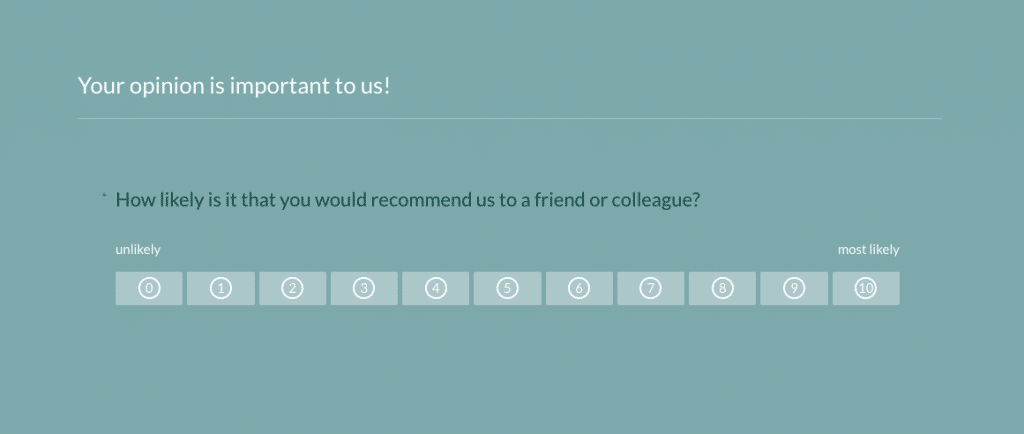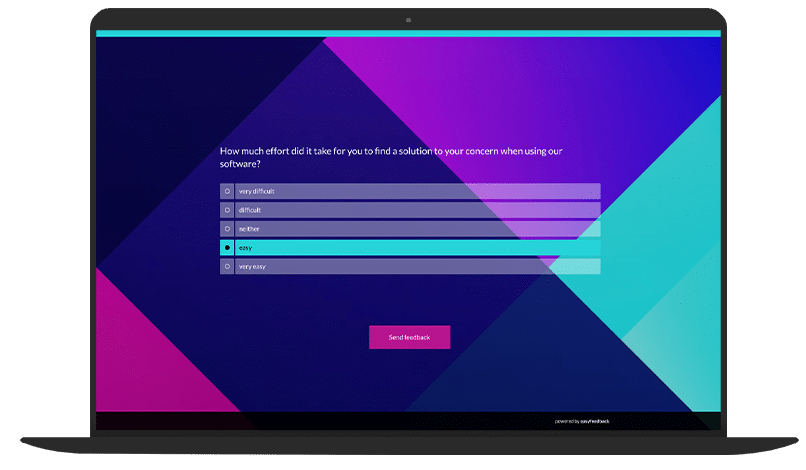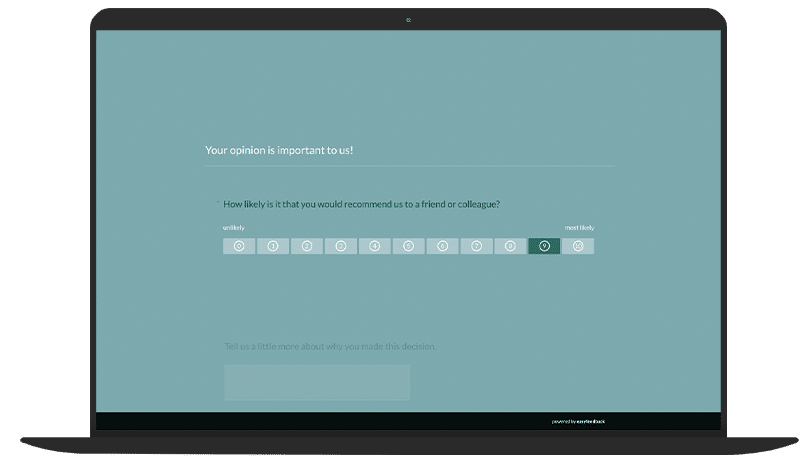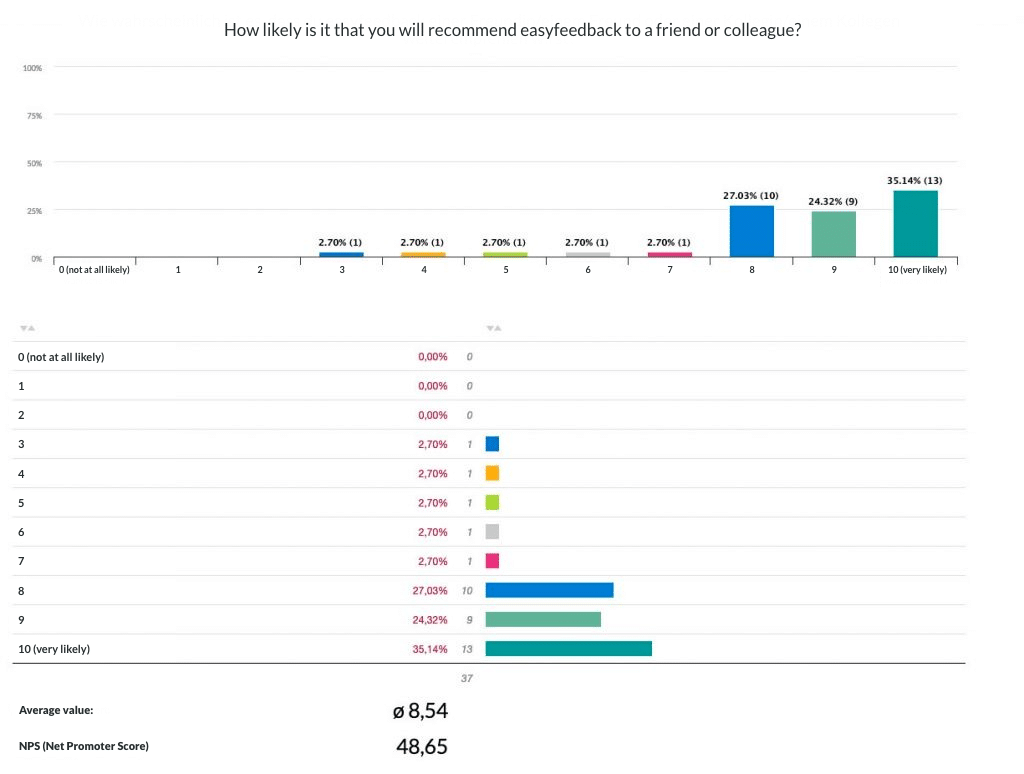What is the Net Promotor Score? NPS explained easily.
The Net Promotor Score (NPS) system goes back to business strategist and author Fred Reichheld. In his book, “The Ultimate Question,” he writes that customer loyalty can be measured effectively and efficiently by answering a single question, making complex market research studies unnecessary.
The ultimate question is:
“How likely are you to recommend this company to a friend or colleague?”
Respondents can answer on a scale of 0 (unlikely) to 10 (very likely). The Net Promotor Score (NPS) is derived from the answer.

The NPS is therefore a key figure that indicates how satisfied customers are with a service, a product or a company. You can read more about how this is calculated and interpreted in the article below.
The NPS can be used to identify services, products or company divisions with which customers are particularly satisfied or dissatisfied. Even in employee surveys, you can use the NPS query, for example, with the formulation:
“Would you recommend us as an employer to a friend?”
The NPS survey is a very simple and user-friendly survey method. Since it takes little time and focuses on the customer’s, or even employee’s, point of view and experience, the participation rate is usually very high.
Basically, the NPS can be surveyed on its own or integrated as an important part of a larger survey.
What alternatives are there to the NPS?
Other methods for quantitative measurement of customer satisfaction include the Customer Satisfaction Score (CSAT), the Customer Effort Score (CES), and the Things Gone Wrong metric (TGW). Even though we are focusing on the NPS in this article, I would like to touch on these briefly:
Customer Satisfaction Score (CSAT) is similar to NPS. Here you ask your customers the question: How satisfied are you with product X?

The Customer Effort Score (CES) takes a different approach. It measures how high customers perceived the effort to do business with you. The question is: How easy or difficult was it for you to solve the task?

The last metric is a bit more unknown. However, it has the charm that you don’t have to take a survey for this one. Things Gone Wrong (TGW) is simply the percentage of customer interactions where something went wrong.
Interestingly, the results of all metrics correlate quite strongly – which means that it is not so decisive which metric you choose in the end. However, the high level of awareness speaks in favor of the NPS. There are now many NPS studies from different industries and sectors that can serve as a valuable benchmark.
Why should you do an NPS survey?
Satisfied customers are more likely to recommend suppliers, products and services to others, have a higher price tolerance and ultimately generate more revenue for your company.
So, customer satisfaction is a key economic success factor for your business. It is therefore wise to consider this indicator as a control variable.
A brief digression: How does satisfaction actually arise?
Put very simply, satisfaction is nothing more than the result of a comparison process. I compare my personal expectations with the actual subjective experience.
Now there are three possible scenarios:
A: My expectations are met = I am satisfied.
B: My expectations are exceeded = I am thrilled.
C: My expectations are not met = I am dissatisfied.
Ultimately, then, there are two levers through which we can influence customer satisfaction. First, the expectations we create with our promises. Second, the quality with which we deliver on this promise.
With an NPS survey, you can make your customers’ satisfaction measurable and comparable. You find out whether your customers are really satisfied, whether there are customer segments in which there is less or more satisfaction than in others and which contact points influence customer satisfaction positively or negatively.
This transparency gives you the opportunity to inquire about the reasons for any dissatisfaction in a second step. You can translate the findings into concrete measures.
Based on the NPS development, you can then continuously measure the success of the implementation, compare it with other companies and make meaningful readjustments in order to recognize how your company stands in the market.
There are clear correlations between the level of the NPS and the following variables:
- Sales
- Upselling rates
- Actual recommendations made
- Follow-up purchases
- Contract cancellations/ churn rates
These are five good reasons to invest in implementing NPS surveys. You’ll find out in a moment what steps you should take to prepare for this and how the survey is done.
Advantages of the Net Promotor Score
- Simple method to determine satisfaction
Since only one question is needed to determine the NPS, you can measure your customers’ satisfaction without a large-scale survey. Of course, the NPS can also be combined with other questions, or you can include the “ultimate question” in a more extensive customer survey.
- Transparency along the entire customer journey
You can easily place the NPS survey along the entire customer journey. This allows you to measure satisfaction at all touchpoints and actively shape the customer experience.
>> Video: 3 Customer Experience Touchpoints <<
- Enables targeted communication
The NPS survey can be anonymous or personalized. The latter has the advantage that you can subsequently enter into a dialog with the respondents. If, for example, a customer gives negative feedback, you can take appropriate measures to change his mind and win him back as a satisfied customer.
- Helps identify multipliers
You also gain transparency about who the fans of your company or your products and services are. They can become valuable multipliers for you if you specifically involve them in your marketing measures.
- Shows strengths and weaknesses of your offering
Through consistent NPS measurement, you gain insight into the strengths and weaknesses in your offering and can clearly measure the effectiveness of your improvement measures and thus also effectively manage them.
- Enables comparison with the competition
Last but not least, you can use the NPS to compare yourself with other companies on the market and see how you compare with the competition in terms of customer satisfaction.
Maximize the benefits of NPS
The question about the willingness to recommend gives you information about the satisfaction of your customers or users, but you do not find out the reasons for the rating.
To find out, you should always ask an additional question. We have already integrated this option in easyfeedback. In a simple text field, the respondent can freely express his or her opinion and experience.
Through the feedback of this additional question option, you receive very important input, on the basis of which you can initiate targeted improvement measures.
How do I prepare a NPS survey?
Before you start with the Net Promoter Score measurement, you should define exactly which construction site you want to tackle with the survey and at which touchpoints of the customer journey you want to reach your customers.
Maybe in your case the customer churn rate is too high, or you want to reduce a high return rate? Even if your primary goal is to get regular, structured feedback from your customers, this is a sensible objective.
The important thing is that you define the goal and then think about a concept.

If you need to convince a higher management level to implement a Net Promoter Score measurement, do it with numbers.
In this case, I recommend that you create a business case by making the return on investment (ROI) transparent and showing when the investment in a Net Promotor Score survey will pay off.
For example, if an increase in revenue of 100,000 euros could be achieved just by having nine fewer B2B customers drop off this year, that’s a tangible number that clearly justifies your project.
Is this the first time you’ve done an NPS measurement in your company? If so, a pilot project is a good idea. Define a specific area you’ll start with to gain initial experience. This can be a regional limitation, or you limit it to a specific business area first.
The experience gained from this test pilot will help you in further surveys. Ideally, you will also gain your first supporters who have had positive experiences with the survey. They are important multipliers for the further roll-out of the NPS measurement.
How does the Net Promoter Score survey work?
The NPS can and is used at various touchpoints within the customer journey. For example, after the consultation, after the purchase, after contact with support, after a complaint, etc. For a first big overview, it can make sense to query the customer’s touchpoints.
As you already know, the NPS measurement always includes the question about the tendency to recommend on a scale of 0 – 10. The query is usually made via e-mail, on the website in a pop-up or on the confirmation page after the purchase.
Here, 10 stands for the highest probability of a recommendation and 0 for the lowest.
With an additional text field, you can find out more about what was particularly good or less good. Or you can simply ask for the main reason for the rating.
Depending on your objectives, it can make a lot of sense to add more questions to your NPS program. To develop the right questions, an internal workshop is also a good idea.

How is the NPS calculated?
The calculation of the NPS is relatively simple. First, we divide respondents into three groups based on their score.
The customers who gave you a score of 0 – 6 are the detractors. They are classified as dissatisfied.
Indifferents or passives are all customers who have given you a score of 7 or 8. They are not included in the calculation of your score.
Anyone who would recommend you with a probability of 9 or 10 is a recommender or promoter. These are your satisfied customers.

The Net Promotor Score is now calculated from the following formula: Promoters in percent - Detractors in percent = NPS.
The Net Promotor Score therefore always has a value between – 100 % and + 100 %. Where – 100 % represents the worst possible result and + 100 % the best possible result.
Here is an example to illustrate the NPS:
Your survey shows that 75 percent of the participants in the survey are promoters, i.e. would recommend you with a probability of 9 or 10.
10 percent give 7 or 8 points and are therefore not included in the calculation as passives. 15 percent of the respondents are classified as Detractors with 0 to 6 points.
Calculation:
The detractors are now subtracted from the promoters:
75 – 15 = 60
The Net Promoter Score for your company is therefore + 60.
When to use the NPS?
The NPS is flexible and can be used at various touchpoints within the customer journey.
It is best used directly after an interaction has taken place. This is because the customer should answer the NPS survey honestly and with a fresh impression, for example, after a consultation, after purchasing a product, after contact with support or after a complaint, and more.
If you take too long with the survey, then the customer may not be able to remember the interaction correctly and there will be a loss of quality in the response to his willingness to recommend.
What is a good NPS?
To be honest, there is no blanket answer to the question of what is a good NPS.
Generally speaking, a Net Promoter Score that is below 0 would be an indication that your company has a lot of problems to solve.
A score between 0 and 30 is a good range, but there’s always room for improvement. If your NPS is higher than 30, it would indicate that your company is doing well and has far more satisfied customers than dissatisfied ones.
An NPS above 70 means that your customers love you and are likely to recommend you very often. The higher the NPS, the more likely it is that new leads and more sales will be generated from customer referrals.
However, the average NPS per industry varies significantly. The example of the marketing agency Retently illustrates this very clearly. In their study, they determined the highest average NPS in the education industry and the lowest in healthcare.

This means that you can’t tell much about a company by looking at absolute NPS alone. It’s also important to consider relative performance, within the industry. In addition to the industry average, this includes looking at the scores of your peers and competitors and how you compare to them.
This is an important indicator of your market positioning. No matter how high your NPS is, it should ideally be better than that of your competitors.
In addition to asking about your current, absolute NPS, you should always keep an eye on whether your company’s Net Promotor Score is moving in the right direction.
Of course, there can and will always be fluctuations – that’s perfectly normal. But the long-term trend of your Net Promotor Score should be positive.
What does a negative Net Promoter Score mean?
Generally speaking, a Net Promoter Score below 0 indicates that your company has a lot of problems to solve. In this case, you have mostly customers who are critical of you and are not likely to recommend your company to others.
In this case, you should work on finding out why they are critical of you or why they are dissatisfied with you, what the problems are, what their expectations are, and try to take meaningful measures to bring the NPS back into positive territory.
The analysis and interpretation of the NPS

Now you have already taken a big step. You have determined your concrete Net Promotor Score. But what do you do with this number? How can you derive meaningful conclusions and measures? In fact, this is where it really gets down to the nitty gritty.
If a negative NPS emerges, the first goal and the first milestone should be the plus in front of the number.
This is where I recommend you take care of the detractors first. You need to find out why customers may not be as willing to recommend you in some areas as you would like them to be. To do so, you will call selected dissatisfied customers and get their feedback. This will give you transparency about the problem from the customer’s point of view.
Most of the time, even the appreciative questioning of the customer leads to an improvement in his satisfaction. But even if there is no direct solution, you can identify the weak points and potential for improvement through the conversation.
When you find out that things have gone wrong, you start the root cause analysis.
The most common method for this is the 5-Why method.
You define the problem and ask the why question. For each answer you get, you ask the why question again. You do this until you get to the bottom of the cause. Often it does not take five questions, but less.
The following example illustrates this:
The customer has not received an answer to his complaint and is very angry.
- Why was there no response? Because the e-mail was lost.
- Why did the e-mail get lost? Because it was sorted into the wrong folder.
- Why was it sorted into the wrong folder? Because the subject of the e-mail was not clear.
Here we would already have an overview of what happened after three why questions and where you can start to eliminate the problem. For example, such sources of error could be eliminated in the future with a standardized e-mail form.
Once you have taken such a measure, you can track the effectiveness of the actions over time using your NPS.
If the score improves, you know that you are on the right track. By regularly collecting the Net Promotor Score, your company can act faster, more agile, and more customer-focused.
How can I improve my NPS? Five helpful tips:
1. Take meaningful action
Collecting and analyzing data is only the first step. But it’s worthless if you don’t follow it up with action. The easiest way to improve the NPS is to reduce the number of detractors and increase the number of promoters. Of course, this doesn’t happen on its own, but through meaningful action.
2. Focus on teamwork
Customer satisfaction can only be improved through teamwork. That’s why you should form an interdisciplinary team of customer service, product development, marketing, sales and management that meets at regular intervals to plan and implement measures.
3. Engage in dialog
Above, you’ve already learned how important it is to learn from your critics. That’s the first tip to improve your NPS. Since the likelihood of recommendation survey is often not anonymous but personalized, you have the chance to get in touch with your biggest critics directly.
4. Learn more
You can also conduct a detailed customer survey. You can control this very specifically and efficiently with easyfeedback. Also ask the promoters what they think your company could improve. With easyfeedback you can create individual surveys for your situation and receive valuable feedback.
5. Use multipliers
Turn your loyal and satisfied customers into multipliers and motivate them to promote your company’s products or services on social media. If you create attractive incentives, your fans will surely be willing to support you.
NPS surveys with easyfeedback
easyfeedback offers you the NPS as a ready-made question type. To determine the NPS at the desired touchpoints, you can place the survey e.g. in an email, on the website, in a pop-up window or on the confirmation page after the purchase.
But you can also invite people to take the survey via QR code. For example, at the end of a training session, you could ask the participants’ satisfaction with the instructor. The possibilities are very diverse.
The results are evaluated in real time at easyfeedback. This allows you to track your score live and react quickly to changes.
The integrated comparison function allows you to compare the NPS with individual touchpoints or departments, for example. Or you can look at the development of the NPS over time.
The development trend of the NPS is particularly interesting if you have changed processes in the company and would like to evaluate whether or how the measures have affected customer satisfaction.
You can find the appropriate survey template right here. Of course, we are also happy to assist you with personal advice. Just contact us, we will be happy to help you.

Conclusion regarding the Net Promotor Score
Customer satisfaction is a decisive success factor for your company and should therefore be treated as an important control variable. Transparency and continuous controlling are essential for this.
The Net Promotor Score can be an important indicator value for this, if it is collected and interpreted correctly. As a provider of NPS surveys, you can easily determine your NPS with easyfeedback.
An NPS survey can help you to identify area-related weaknesses and to initiate change processes in your company on the basis of customer feedback. By continuously monitoring the development of your Net Promotor Score, you can assess whether the conceptual and strategic measures are having an effect.
In addition, the NPS survey helps you to identify your company’s critics and promoters and to enter into dialog with them. Critics can be contacted and the causes of their dissatisfaction can be eliminated.
Promoters can be used as multipliers or involved in case studies or development processes.
Since data collection is very simple and the response rate is high, NPS measurement is a very popular and effective measure in customer satisfaction management.
Maybe soon in your company, too. And if not in the area of customer focus, you can also use the NPS for internal surveys. The method also helps you measure employee satisfaction.
More about Customer Experience
- Everything you need to know about Customer Experience (CX)!
- Creating positive customer experiences with customer experience management
- 3 touchpoints in the customer experience (with video)
- Your way to an effective customer experience strategy!
- 10 methods to analyze the customer experience
- 12 practical examples for improving the customer experience
- 10 metrics to measure Customer Experience
- Customer Satisfaction Score (CSAT) – Measuring Customer Satisfaction differently
- Customer Effort Score (CES): How much effort do your customers have?
- Churn Rate: Key metric for measuring customer loyalty
- The Customer Satisfaction Index (CSI): A key to measuring customer satisfaction




